The plane that left Heathrow fully loaded is almost empty when it touches down at Maurice Bishop International in Grenada. An hour earlier, all but a handful of passengers disembarked at Barbados, our first stop and a much more familiar Caribbean destination.
Grenada’s relative obscurity as a holiday island (it got 178,000 visitors last year, compared to Barbados’s 637,000, the US Virgin Islands’ 782,000 and Aruba’s 1.26mn) has little to do with its slight detachment, the bottom link in the eastern Caribbean chain. Still less with its glorious sugar-sand beaches, and a mountainous interior beckoningly clumped in primary rainforest and veined with dramatic waterfalls. In fact, it’s largely down to the airport we’ve just landed at, and the socialist revolutionary in whose posthumous honour it is now named.
Summer might be the tourist low season in this part of the world, but then Grenada has come through several low decades. In 1983, Ronald Reagan’s administration decided that the newly built airport’s long runway was intended not for tourist jets, as the island’s leader Maurice Bishop insisted, but as a military-grade landing strip for his young regime’s Cuban and Soviet allies. By the time an American invasion force landed, Bishop was already dead, victim of an internal power struggle. The swift US victory that followed ushered in an enduring era of low-key conservative rule, but this traumatic history cast a very long shadow over Grenada’s tourist industry.
The fading of that shadow has thrown light on the island’s potential, revealing opportunities that are rare indeed in this part of the world. My first stay, just a three-minute courtesy-car drive from Maurice Bishop International, is at Silversands Beach House: a boutique resort that welcomed its first guests in February, one of the clutch of upscale developments now popping up around Grenada’s coastline.
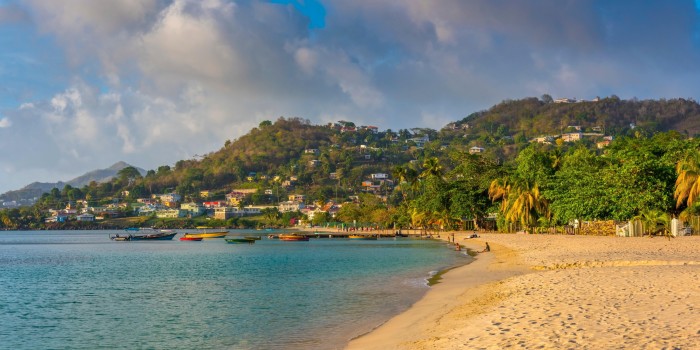 Grand Anse, the island’s most famous beach, stretches for two miles © Alamy
Grand Anse, the island’s most famous beach, stretches for two miles © Alamy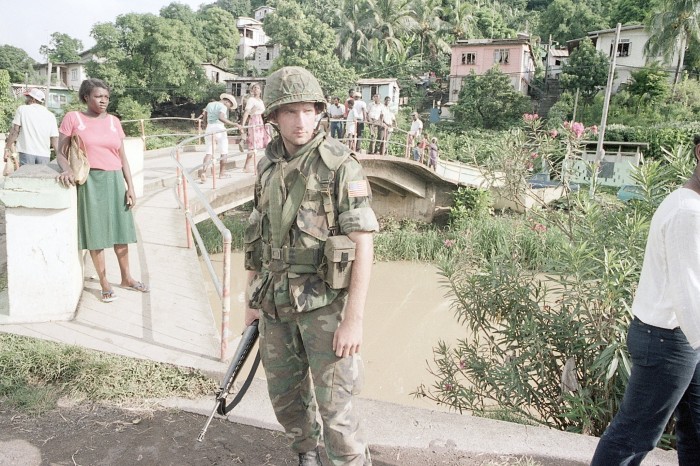 A member of the American invasion force that landed on the island in 1983 © Bettmann Archive
A member of the American invasion force that landed on the island in 1983 © Bettmann Archive
After an arrival ritual involving a necklace fashioned from cinnamon, nutmeg and cloves — signature crops here on the “spice isle” — I’m delivered by golf buggy to my room, one of 28 rectangular white boxes perched high on a promontory. It’s cleverly laid out, the stark angles disguised with sail-like arched canopies, giving the complex the look of a terraced homage to Sydney Opera House. Each guest room is oriented to offer a private overview of the Caribbean from its rear deck, and in my case at least, even from its bed, via full-height, full-width glass doors.
But, panoramic and smartly minimalist as the rooms are, such places will always be defined by their ocean frontage. The crescent of pale sand that stands between the hotel and the Caribbean is a gorgeous little classic of the genre, decorously overhung with palm trees and offering a prospect of green headlands, misty mountains and turquoise water. There’s a compact infinity pool beside the cavernous, open-sided bar and restaurant, all sleek wood and beige rendered concrete, a study in the high-end tropical Modernism that is this sector’s dominant architectural vibe around the globe.
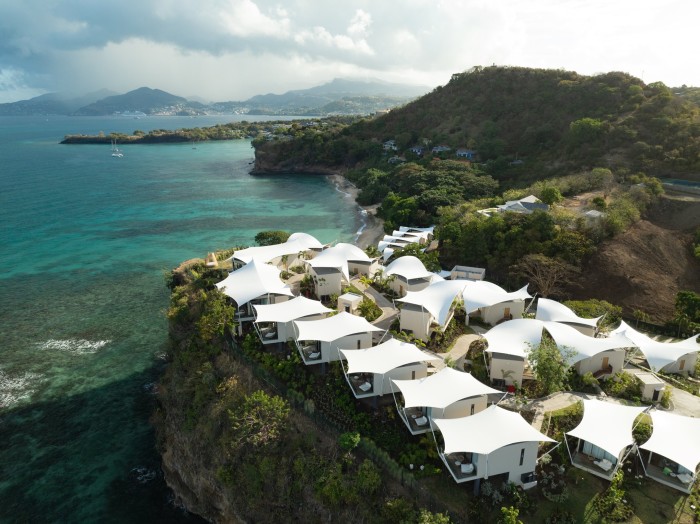 Guest rooms at Silversands Beach House © Sam Todd Dyess Photography
Guest rooms at Silversands Beach House © Sam Todd Dyess Photography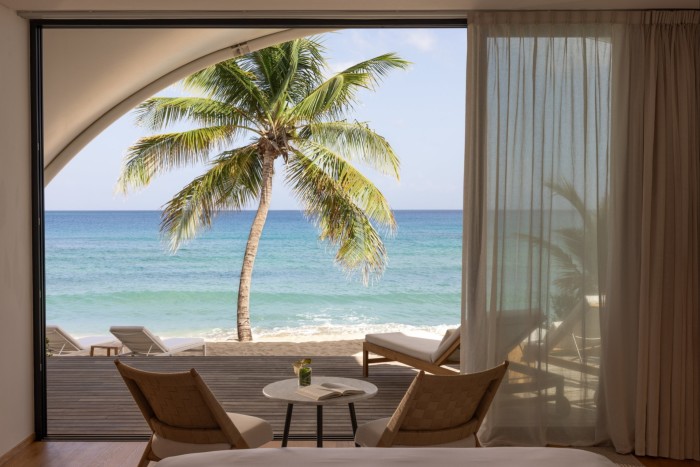 Looking out at the Caribbean from one of the rooms at Silversands Beach House © Sam Todd Dyess Photography
Looking out at the Caribbean from one of the rooms at Silversands Beach House © Sam Todd Dyess Photography
As general manager Michele Giraudo explains, the extravagant size of the catering facilities reflects an intention to attract plenty of off-site diners, particularly through the low season. His principal target market: the 8,000 well-heeled medical students at St George’s University, almost all of them American, along with the even better-heeled parents who pay regular visits on daily direct flights from the US eastern seaboard. Inaugurated in 1976, the university prospered in the Bishop years, its contribution to the national coffers trumping any ideological reservations. Today it ranks as Grenada’s principal economic driver, well above tourism.
Silversands Beach House is owned by Naguib Sawiris, an Egyptian billionaire who made a fortune in telecoms before falling for the island. Just up the coast, around a couple of headlands, lies the hotel’s larger, livelier big brother, set on the powdery pale sand of Grand Anse, an immaculate two-mile beach. Silversands Grand Anse, which opened in 2018, is graced with indoor spaces on the scale of corporate atriums, a coolly appealing spa complex, and a general air of moneyed expansiveness. The property recently served as the location for a glitzy TV game show, The Fortune Hotel, where cameras lingered on its centrepiece attraction: a 100-metre infinity pool, the longest in the Caribbean, flanked by willowy royal palms on its way down to meet those fabled sands.
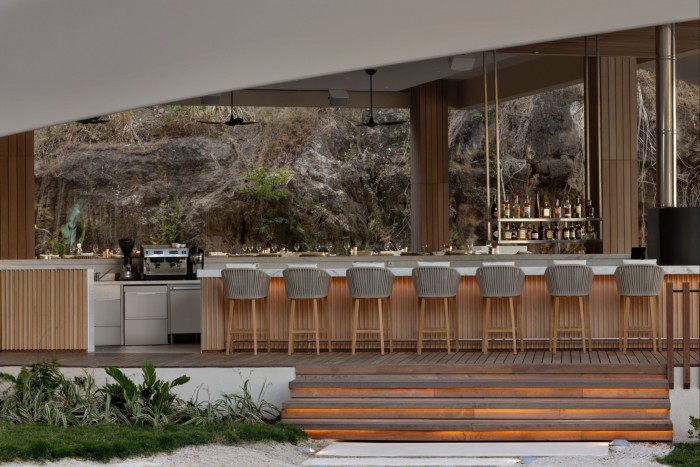 The bar at Azzurro, the Italian restaurant at Silversands Beach House © Sam Todd Dyess Photography
The bar at Azzurro, the Italian restaurant at Silversands Beach House © Sam Todd Dyess Photography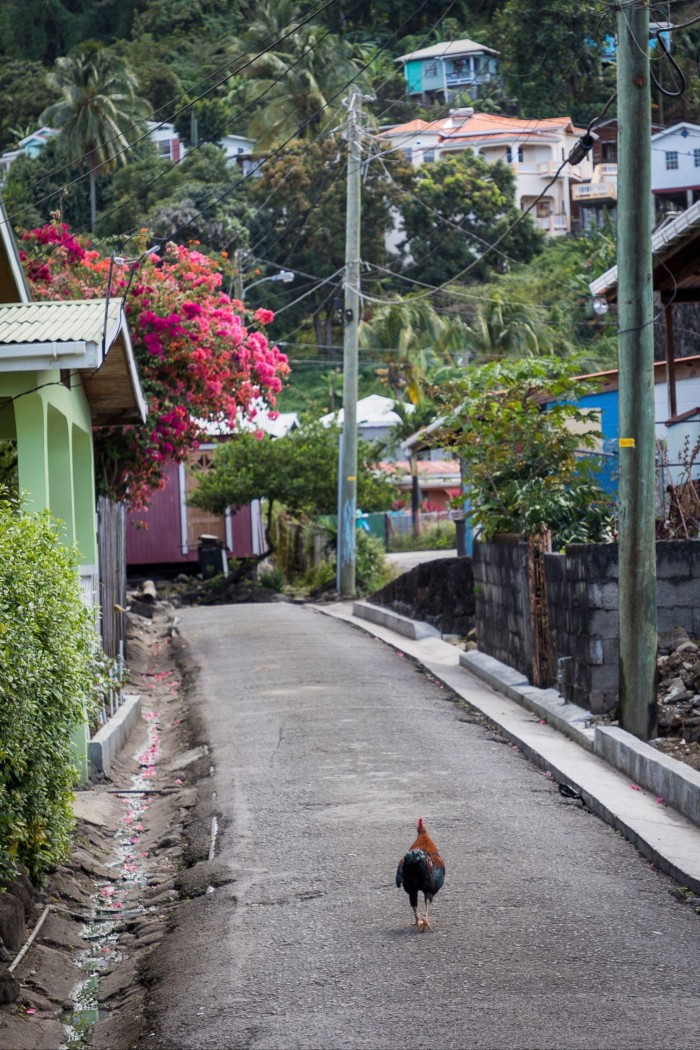 A cockerel wanders the streets © Alamy
A cockerel wanders the streets © Alamy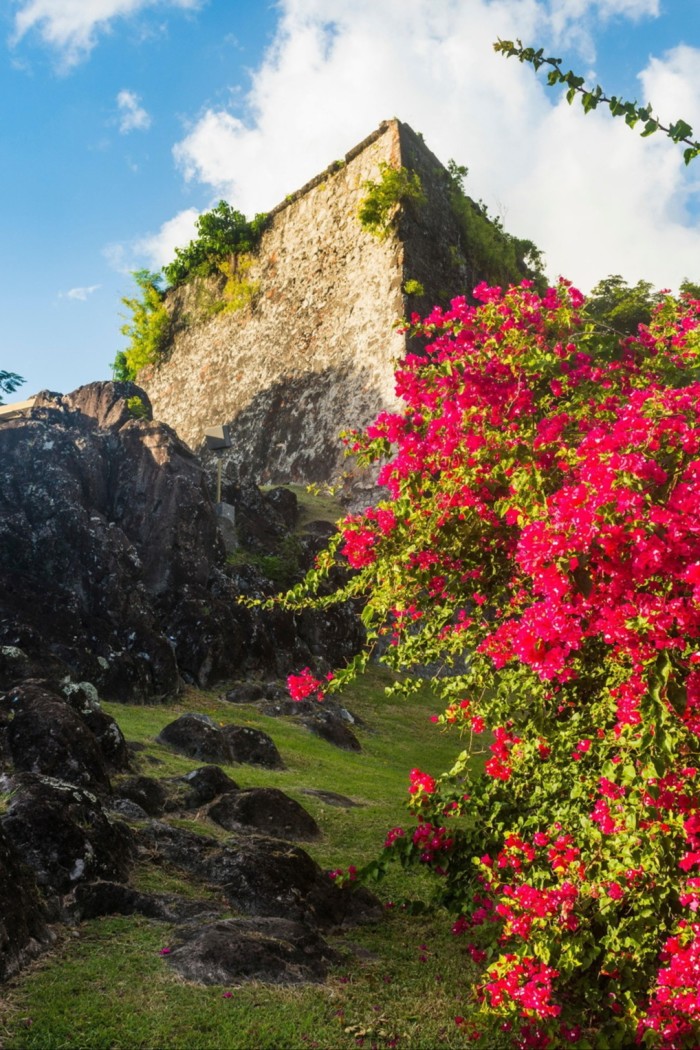 Brilliant red blossoms dot the hillside below Fort George © Alamy
Brilliant red blossoms dot the hillside below Fort George © Alamy
Walking past poolside dozers and unhurried lunchtime nibblers cultivates the strong impression that most guests are more than happy to remain cocooned in the Silversands bubble, whisked between properties by executive SUV for a switch in mood and menus (Italian at the Beach House; Asian fusion at Grand Anse). In search of the bigger picture, I head to St George’s harbour, a ring of colourful but crumbly old warehouses and chandleries that has — in contrast with so many of its Caribbean counterparts — winningly resisted the lure of anodyne, tourist-focused gentrification.
The yawning natural harbour here enticed the usual succession of colonial-era Europeans: the island was first named by Spanish sailors in tribute to the Andalusian city of Granada, before being Gallicised to La Grenade. A century of French occupancy explains the etymology of Grand Anse and many more places on the map — the fishing village of Sauteurs is named after the Caribs who threw themselves off a cliff in preference to surrendering to French soldiers in 1650. The more durable British presence is embodied by the fortress that looms over the harbour from a lofty bluff. Maurice Bishop and 10 colleagues met brutal and mysterious ends up in Fort George — 40 years on, there remains no trace of their bodies.
Danny Donelan’s 25-metre bright red wooden sloop Savvy, acquired from the late entrepreneur Peter de Savary, is a merrily gaudy presence amid the pallid yachts tied up in the harbour, and the vast white Geest banana boat moored at its centre. As we unfurl the sloop’s hefty main sail, Donelan, who runs day trips on the yacht for visitors, explains that St George’s is a popular regional anchorage on account of Grenada’s position below the traditional hurricane belt. But these days you can’t rely on meteorological precedent, and after my return Hurricane Beryl laid tragic waste to Carriacou, the tiny island just 30km north of Grenada where Donelan — and his sloop — were born.
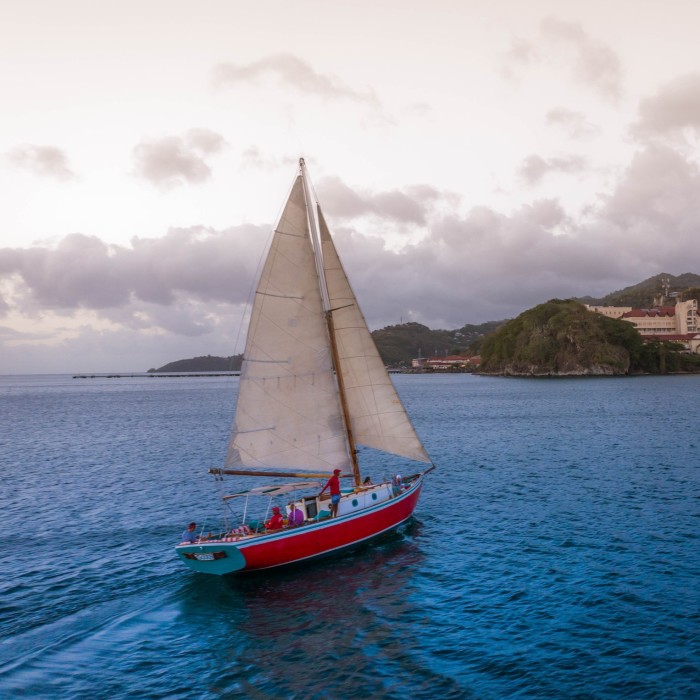 The 25-metre bright red wooden sloop Savvy . . .
The 25-metre bright red wooden sloop Savvy . . . 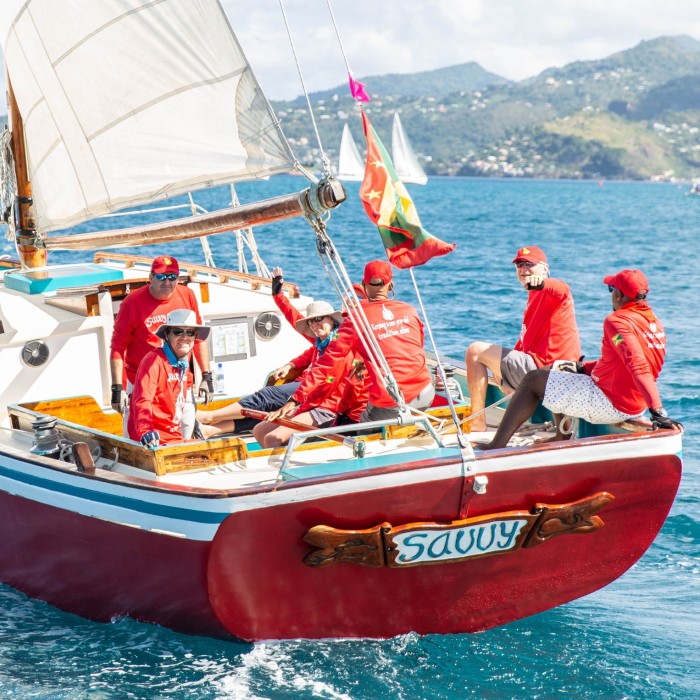 . . . which takes visitors on day trips around the island
. . . which takes visitors on day trips around the island
Under bright and billowing sail we scud out into the open Caribbean, heading south along the coast. I sip cautiously on a rum punch prepared with the fearsome local spirit, typically distilled to such lofty alcoholic heights that it’s banned from departing flights as an explosive fire risk. Musing on the luxury-resort boom, Donelan tells me Sawiris is now going all in: he points out a third Silversands property currently taking shape at the far end of Grand Anse, and — as we tie up back at St George’s quayside — the dockside hill that will host a fourth.
Every island in this chain has two very different faces: calmer seas and broader, sandier beaches on the Caribbean west, with the opposite coast more rugged and bracing, enlivened by the open Atlantic. My second hotel, which opened in May, is boldly sited on the elemental east. The situational reward for Six Senses La Sagesse is splendid isolation, a backdrop of unpeopled hills and beige-tussocked clifftops I come to appreciate fully on one of their e-bikes. The challenge: pitching a beach resort without much in the way of its own beach.
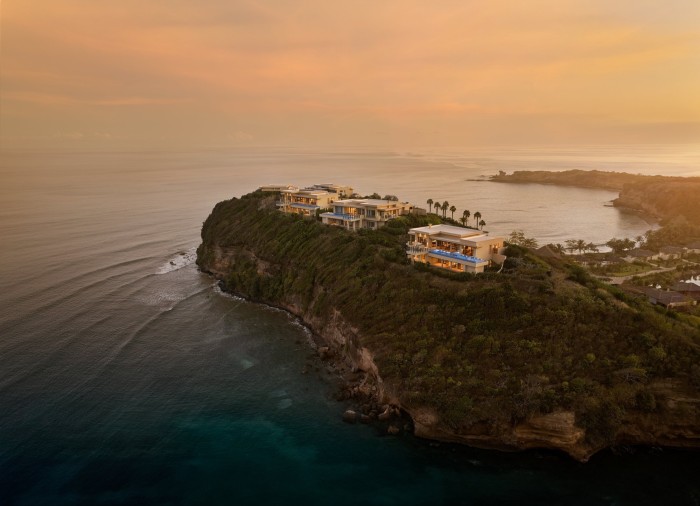 Six Senses La Sagesse, which opened in May in a secluded location on the Atlantic coast © John Athimaritis
Six Senses La Sagesse, which opened in May in a secluded location on the Atlantic coast © John Athimaritis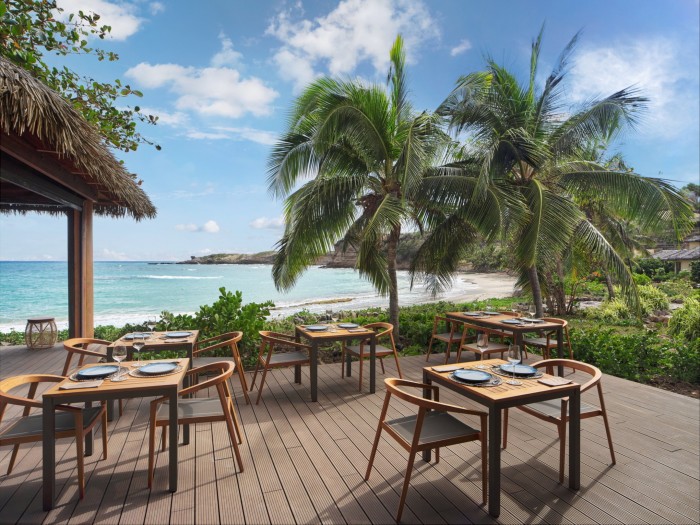 Alfresco dining at Six Senses La Sagesse © John Athimaritis
Alfresco dining at Six Senses La Sagesse © John Athimaritis
By way of imaginative deflection, the property’s 56 rush-roofed hillside suites are arranged around a new saltwater lagoon, a counterpoint to the steely Atlantic beyond. The large main pool is ingeniously aligned with the ocean horizon, creating a trompe l’oeil view of a pale blue sea. Every suite has its own plunge pool. All in all, I never really miss the sand between my toes.
The staff are steeped in first-day cheer and enthusiasm, ferrying me about in golf buggies with the plastic still on their seats. Of course there are work-in-progress downsides, as I appreciate while christening my suite’s outdoor shower to find its landscape screening a couple of growing seasons shy of full modesty. Most conspicuously, there’s an enormous building site next door which will, in a year or so, become a five-floor, 150-room hotel run by the Intercontinental group, which acquired Six Senses in 2019. The aim is to build synergy between these neighbours, to mix and match dining options, spa and sporting facilities.
The challenge of corporate ownership is to retain the original Six Senses ethos, which twins a focus on esoteric wellness with sustainability. Commitment to the former seems resolute when I find myself standing in a large brass bowl as a therapist gently bongs the rim with a dainty ceremonial mallet. The latter is more problematic in an island where rain is increasingly unreliable and inefficiently harvested, and where almost everything — from the vast majority of foodstuffs to the royal palms that line the Silversands Grand Anse pool — is imported from the US. I’m proudly shown round the in-house purification facility that refills the resort’s exclusively glass water bottles, but later learn that the La Sagesse water supply is currently delivered by road tanker.
The remedy for any related cynical dissonance is a visit to Theresa Marryshow’s nearby smallholding. A ministry agronomist and life-long force of nature, since retiring in 2015 Marryshow has been on a crusade to rebuild the island’s grow-your-own tradition, recalling a childhood when every family had a vegetable patch and a couple of fruit trees. “Young people just lost the habit,” she says, showing me round her two-acre cornucopia, its cleverly irrigated orange earth alive with familiar and exotic crops: spring onions, okra, ginger, basil, trees bearing ackee, breadfruit, moringa and soursop. Somehow, this hot little hillside produces a thousand lettuces a week, and a thousand eggs a day. One corner hosts the Six Senses kitchen garden, which surely helps explain why the food there is a cut above anything else I experience in Grenada.
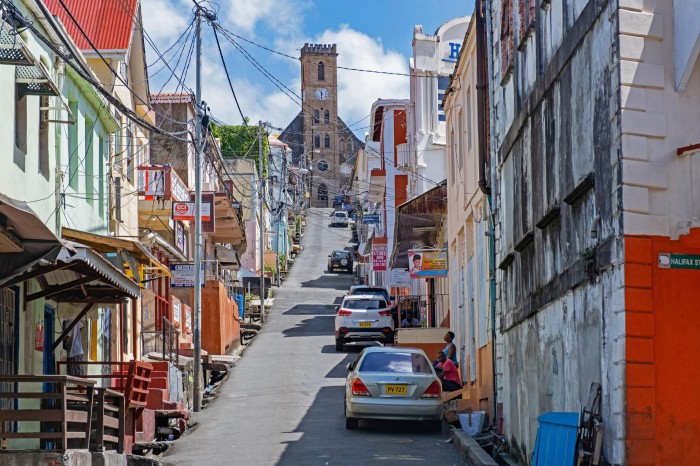 Colourful shopfronts lead up to the Cathedral of the Immaculate Conception in the capital St George’s © Alamy
Colourful shopfronts lead up to the Cathedral of the Immaculate Conception in the capital St George’s © Alamy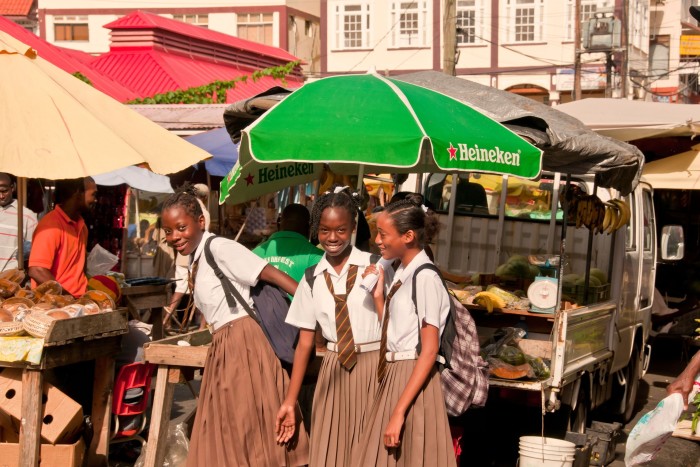 Schoolchildren explore the town’s market stalls © Alamy
Schoolchildren explore the town’s market stalls © Alamy
Caribbean roads can be exuberant, and it’s fair to say that luxury resorts in this region don’t exactly encourage self-drive hire. But to see Marryshow’s pocket farm, and otherwise appreciate what makes Grenada Grenada, you’ll need to hit that bumpy, bustling tarmac.
Up the east coast, sitting gratefully on the tail of a gas-bottle delivery truck that parts the wayward traffic before me, I drive through villages still lavishly decorated in honour of the recent 50th anniversary of independence from Britain, every wall and the tree roots that hang over it striped in the national colours of red, yellow and green. Little gaggles of immaculately uniformed schoolchildren wander among men leading goats. The road veers upwards and inland, through clusters of flame-topped flamboyant trees, and loftier mahoganies and teaks as we skirt those mountain-top rainforests.
There’s a pervasive mood of good cheer and quiet prosperity; I witness none of the startling poverty that lurks behind the tourist facade in so many Caribbean islands. After an all-action hour, up in Grenada’s top right-hand corner, I ease to a halt by a dusty field that was once a taxiway at Pearls, the island’s now defunct original airport. Standing in it are the rusted hulks of two aircraft, one with Aeroflot painted on its fuselage in barely legible Cyrillic, the other bearing the faded livery of Cubana Airlines.
Many islanders have stoutly assured me that the legacy of Comrade Bishop is all around, in the island’s deep respect for an education system built largely by his regime, in its durable standard of living across the board. Here, amid an incongruous scatter of picnic tables, is the first act of a tale of two airports, and the last tangible reminder of this lovely little island’s poignant, curious cameo in the cold war’s Caribbean theatre.
Details
Tim Moore was a guest of Scott Dunn (scottdunn.com), which offers a six-night itinerary in Grenada from £4,900 including three nights at Six Senses La Sagesse and three nights at Silversands Beach House, and private transfers. Return flights from London would add about £700 per person
Find out about our latest stories first — follow FTWeekend on Instagram and X, and subscribe to our podcast Life and Art wherever you listen
Author :
Publish date : 2024-09-12 13:00:00
Copyright for syndicated content belongs to the linked Source.
—-
Author : theamericannews
Publish date : 2024-09-18 06:54:19
Copyright for syndicated content belongs to the linked Source.